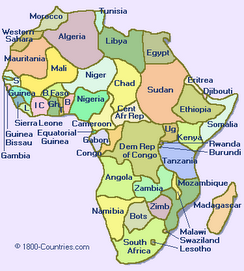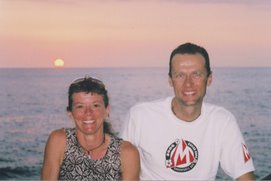We had quite a bit of travelling to do to get from Kampala, Uganda to Mombasa, Kenya! First was a bus ride from Nairobi to Kampala, it's only about 500km but took 14hrs as the roads are so rough in Kenya (the infrastructure in Kenya has deteriorated as a result of economic & aid embargoes at the end of Moi's reign) we even went on the luxury 3 seats per row bus! We broke the journey in Nairobi to do a day of souvenir shopping in Nairobi. We then took the overnight sleeper train from Nairobi to Mombasa. This train ride is touted as evoking the old Victorian colonial era of train travel but sadly the train ride is a mere shadow of it's former self . I have to say that the Zambia to Dar Es Salaam train ride was more exotic and interesting than this one. Never the less it was a comfortable and smooth ride.
We spent a day in the city of Mombasa, it's a nice place and we wondered around the Fort Jesus with it's immensely think coral walls and through the narrow streets of the old town so reminiscent of Stone Town on Zanzibar. We splurged and stayed at the newly renovated Castle Royal Hotel which has retained it's character and charm and has a lovely open terrace overlooking the street.

Fort Jesus Mombasa
Then it was time to relax on the beach! We stayed at the quiet and secluded Tiwi beach 30km south of Mombasa in a lovely self catering thatched bungalow with a big veranda overlooking the sandy beach. Every day the local fishermen would come to sell us their catch (which, thankfully they filleted for us!). Against Chris' better judgement I bought live crab for the first evening and had quite a challenge dealing with the snapping claws and extracting the crab meat once cooked!!

Our bungalow at Tiwi Beach, Mombasa

Tiwi Beach, Mombasa from the veranda of our bungalow

Zoe and the claw snapping crabs, Tiwi Beach, Mombasa

Tiwi Beach, Mombasa

Fishermen in dugout canoe gliding by the Sand Island and reef, Tiwi beach
On our return to Nairobi we had one day before catching our plane to the UK. We went to the Nairobi National Park for a final fix of African animals. This park is in sight of the city skyline but still has quite a few animals. We saw heartbeast, zebras, giraffe, ostriches and our first Elands.

Eland, Nairobi National Park

Ostrich, Nairobi National Park

Yellow Necked Francolin, Nairobi National Park

Heartbeast and zebra, Nairobi National Park with the Ngong Hills of Karen Blixen fame in the background.
We broke our journey back to Canada with a 2 day stop over in UK to visit Zoe's parents, brother, sister-in-law and their lovely little daughter, Emma. She's not even 2yrs old and already a daring high flying swing addict and to our amazement can also identify a Porsche from all other cars - Porsches are all called "daddy's car"!!













































